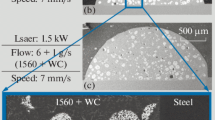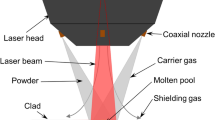Abstract
High cooling speed in laser cladding process yields excellent metallurgical and mechanical properties. Indeed, this attribute along with the process’s additive nature contributes significantly to the development of thermal stresses that are the major cause of any possible crack and delamination formation across the deposition. This limitation is more common for additive materials such as chromium carbide which are crack-sensitive by nature during most of the hard facing process. In the current work, A 90 wt% Cr3C2–10 wt% NiCr-based laser clads were developed with and without preheating the substrate T91. In the case of preheating, the substrate was preheated at 200 °C, 400 °C, and 600 °C temperature before clad deposition. Liquid dye penetration test was carried out on the developed composite clads, whereas 20 numbers of cracks per unit length were observed on without preheated substrate. The microstructure studies revealed that the preheated substrates have shown a crack-free structure as compared to those without preheating of the substrate. The clad height, heat-affected zone, and dilution rate were found reliable in the case of cladding developed at preheated temperature (200 °C) as compared to higher preheated temperature (400 °C and 600 °C). Energy-dispersive X-ray spectroscopy study cleared that the chromium-rich phases were more segregated with iron and nickel elements on the developed clad on the preheated surface as compared to the surface developed on without preheating of the substrate. The average microhardness of the developed composite laser clads with and without preheating of the substrate was 802 ± 94 HV and 878 ± 68 HV, respectively. This was found to be much higher than the substrate microhardness (439 ± 12 HV).






Similar content being viewed by others
References
Dubourg L, Ursescu D, Hlawka F, and Cornel A, Wear 258 (2005) 1745.
Santos E C, Shiomi M, Osakada K, and Laoui T, Int J Mach Tools Manuf 46 (2006) 1459.
Alimardani M, and Toyserkani E, Appl Soft Comput 8 (2008) 316.
Chen H Y, and Huang S J, Int J Manuf Technol 24 (2004) 667.
Adak B, Nash P, and Chen D, J Mater Sci 40 (2005) 2051.
Pinkerton A J, and Li L, Appl Surf Sci 208–209 (2003) 411.
Pinkerton A J, and Li L, Thin Solid Films. 453–454 (2004) 471.
Cho C, Zhao G, Kwak S, and Kim C B, J Mater Process Technol 153–154 (2004) 494.
Qi H, Mazumder J, and Ki H, J Appl Phys 100 (2006) 1.
Nickel A H, Barnett D M, and Prinz F B, J Mater Sci Eng A 317 (2001) 59.
Klingbeil N W, Beuth J L, Chin R K, and Amon C H, Int J Mech Sci 44 (2002) 57.
Jendrzejewski R, and Sliwinski G, J Appl Surf Sci 254 (2007) 921.
Alimardani M, Toyserkani E, Huissoon J P, and Paul C P, Opt Lasers Eng 47 (2009) 1160.
Amado J M, Tobar M J, Yáñez A, Amigó V, and Candel J, J Phys Proc 12 (2011) 338.
Song W L, Echigoya J, Zhu B D, Xie C S, and Cui K, Surf Coat Technol 138 (2001) 291.
Zhou S, Zeng X, Hu Q, and Huang Y, Appl Surf Sci 255 (2008) 1646.
Weisheit A, Rittinghaus S, Dutta A, and Majumdar J, Opt Laser Eng 131 (2020) 106041.
Sun D, Fabijanic D, Annasamy M, Gallo S, Fordyce I, Leary M, Easton M, and Brandt M, J Laser Appl 32 (2020) 1.
Ding C, Cui X, Jiao J, and Zhu P, Materials 11 (2018) 1.
Liang M C, Huang J, Jiang R, Hui Y, Xie Z, and Liu S, Eng Fail Anal 31 (2013) 320.
Shengfeng Z, Xiaoyan Z, Qianwu H, and Yongjun H, Appl Surf Sci 255 (2008) 1646.
Acknowledgements
The work is carried out in the center for laser processing of materials, ARCI Hyderabad. The authors would like to express their gratitude to the director, team leader, and also special thanks to Mr. J Shyam Rao, technical assistant, CLPM, ARCI-Hyderabad.
Author information
Authors and Affiliations
Corresponding author
Additional information
Publisher's Note
Springer Nature remains neutral with regard to jurisdictional claims in published maps and institutional affiliations.
Rights and permissions
About this article
Cite this article
Hebbale, A.M., Tak, M. & Bathe, R. Microstructural Studies of Composite (Cr3C2–NiCr) Laser Clads Developed on Preheated Substrate T91. Trans Indian Inst Met 74, 593–600 (2021). https://doi.org/10.1007/s12666-020-02150-0
Received:
Accepted:
Published:
Issue Date:
DOI: https://doi.org/10.1007/s12666-020-02150-0




